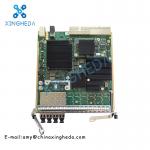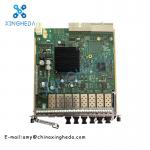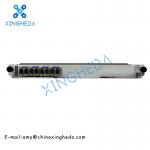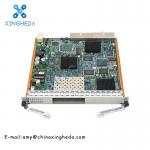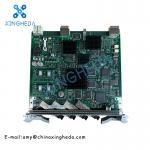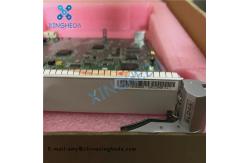HUAWEI SLD4A SSN1SLD4A 03053174 OSN3500
SSN1SLD4A20 STM 4 interface board
Functions and Features:The SLD4A transmits and receives STM-4 optical signals, performs
O/E conversion for the STM-4 optical signals, extracts and inserts
overhead bytes, and generates alarm signals on the line.
Table 1 provides the functions and features of the SLD4A.
Table 1 Functions and features of the SLD4A
| Function and Feature | SLD4A | | Basic functions | Receives and transmits 2xSTM-4 optical signals, and processes
2xSTM-4 standard or concatenation services. | | Specifications of the optical interface | - Supports different types of standard optical interfaces, namely,
the I-4, S-4.1, L-4.1, L-4.2, and Ve-4.2.
- The characteristics of the optical interfaces of the I-4, S-4.1,
L-4.1, and L-4.2 types comply with ITU-T G.957.
- The characteristics of the optical interface of the Ve-4.2 type
comply with the standards defined by Huawei.
| | Specifications of the optical module | - Supports the detection and query of the information about the
optical module.
- Provides the ALS function. The optical interface supports the
setting of the on/off state of a laser.
- Supports the usage and monitoring of the SFP optical module, which
facilitates the maintenance and upgrading of the optical module.
| | Service processing | Supports the VC-12 services, VC-3 services, VC-4 services, and
VC-4-4c concatenation services. | | Overhead processing | - Processes the section overheads of the STM-4 signals.
- Supports the transparent transmission and termination of the path
overheads.
- Supports the setting and query of the J0, J1, and C2 bytes.
- Supports one or two channels of ECC communication.
| | Alarms and performance events | Reports various alarms and performance events, which facilitates
the management and maintenance of the equipment. | | Protection schemes | - Supports the Two-fiber ring MSP, Four-fiber ring MSP, Linear MSP,
SNCP, SNCTP, and SNCMP.
- Supports the fiber-shared MSP and SNCP. One SLD4A supports a
maximum of 2 MSP protection rings.
| | Maintenance features | - Supports inloops and outloops at optical interfaces.
- Supports inloops and outloops on VC-4 paths.
- Supports warm resets and cold resets. The warm reset does not
affect services.
- Supports the query of the manufacturing information of the board.
- Supports the in-service loading of the FPGA.
- Supports the upgrade of the board software without affecting
services.
- Supports the press-to-collect function in fault data collection.
- Hot board swapping.
|
Huawei OptiX OSN 3500 presentation:
The OptiX OSN 3500 is an intelligent optical switching system with
universal switch architecture. That is, the OptiX OSN 3500 can be
used in packet mode (MPLS/MPLS-TP based ) or in TDM mode. When used
with the other equipment of Huawei, the OptiX OSN 3500 supports
various networking applications, such as the pure packet mode
application, hybrid networking application (overlay networking of
the packet mode and TDM mode), and pure TDM mode application. By
using a proper networking solution, the data service and
conventional SDH service can be processed in the optimal manner.
The OptiX OSN 3500 transmits voice and data services on the same
platform with high efficiency.
Features:
Universal Switch Architecture, Multi-Service Transmission
With a universal switch architecture, the OptiX OSN equipment meets
requirements for bearing conventional services and the growing
number of packet services.
Support 3G/LTE Mobile Backhaul, Improve Service Transmission
To address 3G/LTE mobile backhauling requirements, Huawei's
equipment provides complete transmission solutions in the packet
domain, converging and grooming services at the core layer of a
wireless network.
Built-In WDM, Flexible Networking
The OptiX OSN 3500 uses the built-in WDM technology to transmit
several wavelengths over one optical fiber. In this context, the
OptiX OSN 3500 can be interconnected with the WDM equipment.
TP-Assist Helps Carefree Packet Network Maintenance
With MPLS/MPLS-TP technology, TP-Assist solution supports carefree
packet network maintenance capability. TP-Assist solution does not
only provide planning tools for packet network, but E2E
media-independent configuration and instrument-free network
deployment capability. Furthermore, rich performance monitoring and
automatic fault isolation can be provided for daily network
maintenance.
If you are interested, please let us know the specific model. We
will provide the best service and the best price!
Pr |
